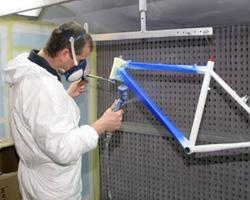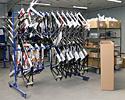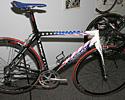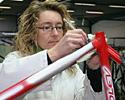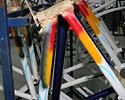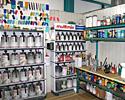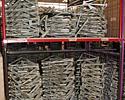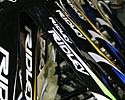
Recently on Cyclingnews.com |
Ridley bikes in the making, October 15, 2006
Ridley Bikes: Into the Aladdin's caveBy Shane Stokes It was a superb Tour of Romandie for Ridley, frame suppliers to Davitamon Lotto, back in April. Robbie McEwen took the Belgian team's first European win of the year when he galloped to success on day one of the Swiss ProTour event. 24-odd hours later, Chris Horner did the same, jumping away in the closing kilometres of the mountainous stage to Porrentruy. Best of all, Cadel Evans bounced back from his indifferent Classics form to ride a stormer of a race, riding strongly in the mountains and then scooping overall victory with a win in the final day time trial. By then, you could forget all that talk of a slow spring Classics campaign; from then on, as Spring turned to Summer and the weather became warmer, the team's performances just became hotter and hotter. May saw Gert Steegmans take stages in the Four Days of Dunkerque and the Tour of Picardie. In June Robbie McEwen took three stages of the Giro before doing a 'three-peat' again the next month in France on his way to a third green jersey, while Cadel Evans rode consistently to take fifth in the Grand Boucle. McEwen then capped off a successful Autumn by claiming his second-cosecutive victory in Paris-Bruxelles. Davitamon-Lotto, and Ridley, were back on top just when it mattered.
The big Belgian company is supplying frames to two big road teams this year, Davitamon-Lotto in the ProTour and Unibet.com in the Continental Professional ranks. The latter has ambitions to step up a level, which could see Ridley become one of the few companies supplying to two ProTour squads. The company is also in partnership with the Fidea cyclo-cross team of world champions Erwin Vervecken and Zdenek Stybar, plus several smaller teams in Europe and the US. Although Ridley is a relatively new manufacturer, it has some impressive results to date; in the past five seasons its road and cyclo-cross riders have taken a total of 25 national and world championship titles. This list includes two world gold medals for cross competitor Bart Wellens, the 2001-2002 title for Mario De Clerq and victory for current champ Erwin Vervecken. Zdnek Stybar took the Espoir world title earlier this year on the bike, while national cross titles have been won by riders such as Roger Hammond and Niels Albert, who took both the Belgian Espoir and the European title in 2005.
The road haul is similarly impressive, with Robbie McEwen, Leon Van Bon, Serge Baguet and Hammond collecting Australian, Dutch, Belgian and British titles. And while world champ Tom Boonen is currently supplied bikes by a different manufacturer, he won his 2001 Belgian Espoir crown on a Ridley. He remains on good terms with the company, which is just as well, as his father Andre currently works for them! That list of palmares reflects considerable success, and so too the history of the company itself. Back in 1990 Race Productions NV started out as a one-man frame building and bike painting company, with founder Jochim Aerts hiring his first employee one year later. In 1997 the brand 'Ridley' came into being and several new ranges were introduced. Two years later the first frames from Taiwan were used, and then in 2000 Ridley started the development of its first carbon frame, the Damocles becoming available in 2003. Simultaneously, the company was developing the brand '4ZA', a line of high-end carbon components.
This new line, plus the ongoing growth of the frame business, saw the headquarters double in size in 2002, going from 2,500 to 5,000 m2. At the same time, plans were being made for an expansion into international markets, and in 2004 Ridley started targeting specific European countries. By this stage all of the frames were coming from Taiwan, the company stating that their new partners were more reliable in terms of quality and deliver in better time than the previous Italian suppliers. Last year saw the team begin supplying the ProTour team Davitamon-Lotto, the association of the two helping to increase brand awareness of its frames while also receiving feedback from the pro riders which would be used to tweak the Damocles frame. The company's headquarters increased by a further 50% in order to cater for the growth in market demand; this jump was partly due to the expansion into the US market. Earlier this year, the new flagship frame was presented, the Noah featuring an integrated seat-tube and aero geometry. In terms of figures, the company's growth has been impressive. Until 2003 the market comprised just five countries. This has now jumped to 35, extending as far afield as Australia, South African, the USA and Malaysia. Unsurprisingly, sales have rocketed; in 1999, sales were 1.815 million. By the end of 2005, this level had jumped almost tenfold to just under 11.8 million, and now Ridley is planning to move to even bigger premises in the near future. What started as a one-man frame-building and painting business really has changed beyond all recognition. The factory tour:
Just before the Tour of Romandie back in April, Ridley invited a group of journalists to an open day at their current headquarters in Belgium. Situated near the Zolder racecourse, site of the 2002 world road race championships, the area - and Belgium in general - is a hotbed of cycling, something which has played a big part in the success of the company. The tour began with an in-depth presentation about Ridley's history, current products and future direction. In short, the strategy is about continued expansion, but the impression was given that this will not be done at the expense of quality. Careful planning and organisation are being employed to ensure that things continue to work well, and that the reputation which has been built up over time is preserved.
That care was evident on numerous occasions during the visit. We were shown around the headquarters by one of the company's employees and several examples of this attention to detail were seen, ensuring that there are no errors during the assembly of the eighty bikes per day at the factory. As an example, one of the first things that is done when frames arrive is a small number card is attached to the dropout of each in order to ensure that precise tracking can be kept throughout each stage of the process. "This is done to make sure that they are all matched up to the order form," explined the guide. "Once this card is attached we can easily see what must be done to each frame, making sure that there are no errors. It also helps us to track them at any stage, as we can check our system to find out exactly where a frame is at any given point." While some of them are painted in the Far East, many are sprayed in Belgium, making it doubly important that the right colours, coatings and treatments are applied to each.
Having seen some of the finished bikes during the information presentation, the journalists present headed deep into the factory to see more. It was a mouth-watering display; walking through a door from the presentation area was like entering Aladdin's cave, the group strolling through large storage rooms filled with thousands of juicy bike bits, including shelf-loads of wheels, components and tyres. Resisting any kleptomaniacal urges, the pack moved on. The next storage area was more impressive again, with row upon row of bike frames waiting to be built up and/or shipped out. For the former, the assembly process was sped up through the use of a mechanised headset press, which puts the cups in quickly and with precisely the correct force. It helped to keep things moving on quickly, and added to the overall impression of efficiency and smooth productivity in the factory.
Further inside the grotto, the preparation of the frames was being done. Each stage of the process was seen, from the initial powder coating of frames to the mechanised cutting of transfers and screens, which will be used to block off different parts of the frame during the painting process. Up to three different paintjobs can be applied to each, helping to achieve the distinctive mix of colours and 'look' of a Ridley bike. In order to eliminate errors, the plastic transfer sheet is also inscribed with a number which corresponds with the metal card attached to the frame. Again, this is used to ensure the correct painting of the bike. After seeing the transfer production process, those present were taken into a large area of the factory where the actual spraying is done. Each worker has their own separate workspace, above which a large extractor vent helps keep the paint fumes to a minimum while they work. For more demanding jobs, there is a large dust-free cabin to one side of the room. "This is used if dangerous substances are being used, to make sure fumes are kept to an absolute minimum," explained the tour guide. "It also ensures that there is no dust or hairs which could otherwise ruin the coating." Once each stage of the painting process is completed, frames are set aside to dry. Again, the barcode of each order is scanned to keep a record of where they are and what processes have been completed. If desired, large ovens can be used to speed up the drying process. However guidelines are clearly marked on the doors of each, ensuring that each Ridley is treated in the right way, depending on the materials used. After all, there's not much point in going through the whole painting process, only to make a bag of things by baking a carbon frame at too high a temperature…
Aside from the coating of the bikes, the machining processes were also seen. A worker called Angela is responsible for the first quality control, checking over each Ridley and also milling the headtube and putting the thread in the bottom bracket with specialised machines. Another woman takes off the screen transfers, wielding a scalpel with the kind of surgical precision borne out of countless hours of practice. Moving quickly and fluidly, she unveils the finished frames, which emerge from underneath the paint-coated coverings and are then dusted down with a compressed air hose. After that, all that remains to be done is to coat each of them with lacquer, protecting the finish and giving them even more of a shine. They are then readied to be built up as complete bikes or shipped out as frames to thousands of sure-to-be satisfied customers. This number includes the riders of Davitamon-Lotto and Unibet.com, who doubtlessly will be winning more big races as the season progresses. Evans and co. started the ball rolling in Romandie and it didn't stop all summer; expect to see Ridley bikes leading the peloton home in other events over the months and years ahead. PhotographyFor a thumbnail gallery of these images, click here Images by Bastiaan Heus
Images by Ben Atkins/CyclingNews
|

